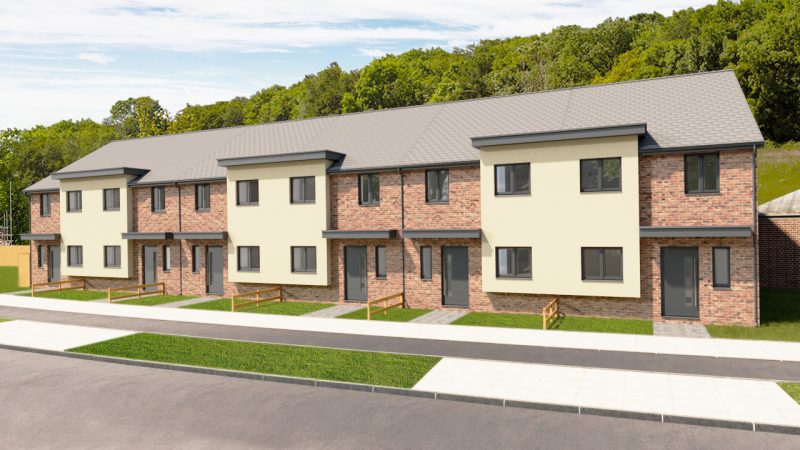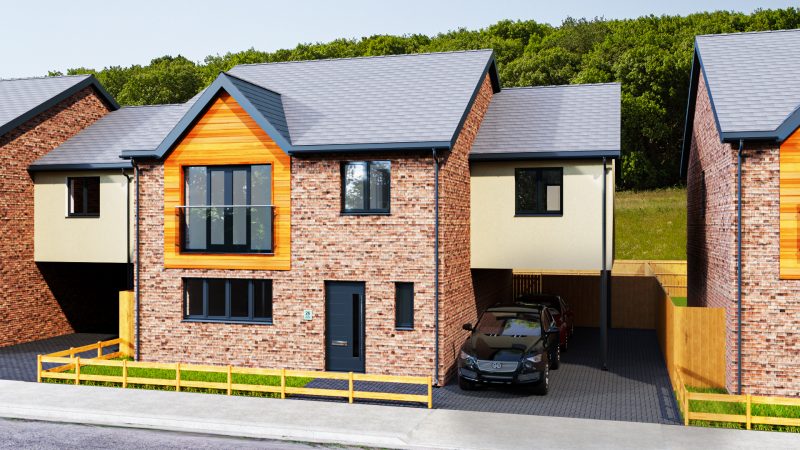Anyone interested in building in East Sussex will be interested to learn that Leaper Land Promotion has submitted a planning application for 22 serviced plots at Horam.
The proposals, which include eight affordable homes, were submitted to Wealdon District Council following consultation with local residents, and has now been validated. You can see the application on the council’s website.
Anyone wishing to build their own home are encouraged to leave positive statements of approval for the site, to help counter the inevitable objections that all planning applications attract.
Set on a 0.8 hectare site, is on the south of the village of Horam, set between recent housing and the Sussex countryside. The homes have been designed by award-winning architect Pollard Thomas Edwards and planning consultancy Rural Solutions, working in conjunction with the land owner.
The homes will offer a range of choices in the homes, including a palette of designs and materials that buyers can use to customise their design. This will create a sustainable and valuable new addition to the village that the Leaper believes will be an asset for the future. The inclusion of custom build as well as affordable homes will increase housing choice in the town for existing and new residents of the village.
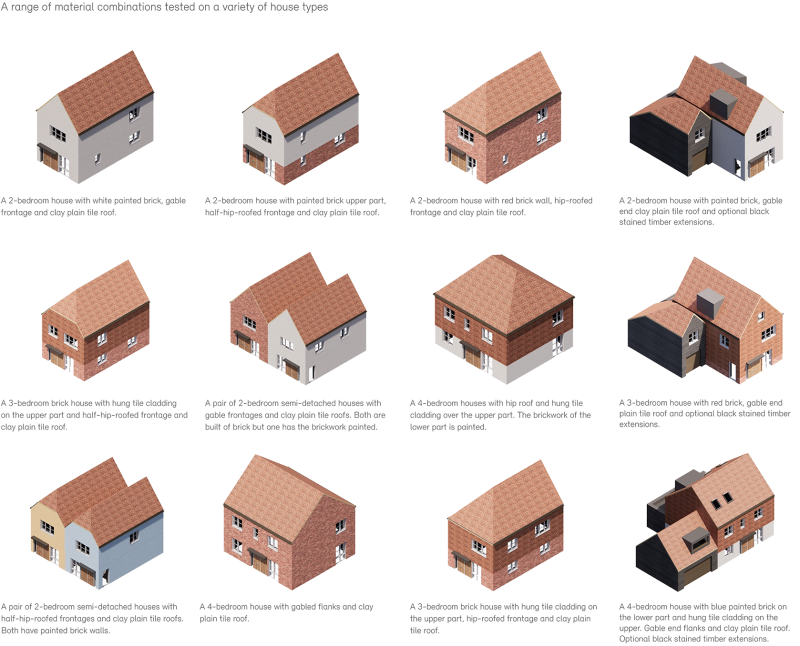
The design has been carefully framed to boost local biodiversity across the site to connect with the woodland buffer zone between the site and the open countryside.
“Leaper’s latest self and custom build scheme at Horam in East Sussex falls within a draft updated village development boundary and was supported at pre-app. A detailed design code has been developed to best reflect the local vernacular architecture and the scheme if approved will provide much needed plots for the local area,” says Ben Marten, Director of Leaper Land.
Find Wealden District Council’s Self Build Register on the Right to Build Portal
If you have land that you think would be suitable for custom or self build, get in touch with Leaper Land.
Images: Pollard Thomas Edwards/Leaper Land
Stellco Homes has recently joined NaCSBA, to reflect its move into the custom build homes market to broaden its offer. With over 20 years’ experience as a housebuilder, custom build is a logical extension for the firm to expand in 2021, with activity focused around Bedfordshire, Buckinghamshire & Hertfordshire.
Angelo Baccarella of Stellco Homes explains that, for them, custom build is a natural progression of its existing business. “We see the custom route as a continuation of the traditional ‘bespoke’ service,” says Baccarella.
Currently, the company is looking for sites to bring on, and is hosting its own register for people wanting to build in Beds, Bucks and Herts, to track local demand. Sign up to hear about their sites, for free, by joining the company’s register for people wanting to build. However, it also encourages prospective buyers to sign up to their local authority’s registers, too, via the www.righttobuildportal.org
What is Custom Build for Stellco Homes?
Stellco sees custom build as a way for people to build their dream home without the stress. Once sites are ready, customers can come to the table with plots ready to purchase and a selection of designs in place that can be customised.
They are then able to work with the company, with everything discussed with an experienced property developer who will ensure the customer’s requirements are met to a high standard.
Stellco Homes: five reasons for choosing a custom build:
- It simplifies finding a plot
By buying small sites of around 10 plots or under, Stellco can secure a small development that is perfect for a custom build home, offering a route to land.
- Homes are designed around you
With a custom built home, you can customise everything to suit your needs. There are many reasons why someone may want to customise their home such as making it more accessible or to make a more inclusive family environment.
- Fixed costs
With Stellco, there’s an option to fix the costs once the design is agreed upon, removing the risk of costs creeping up. Stellco Homes works with buyers budgets to create a fixed cost plan to avoid any expensive surprises.
- Cheaper to run
With a custom build its far easier to build well beyond building regulations, to create a more energy efficient home, that is, therefore, cheaper to run.
- Time
Self-building is time consuming, but a custom build can help make a build realistic if you’re juggling a job and a busy family. Custom build helps create a stress free process, as the developer oversees the entire process, keeping it on track and on budget.
Stellco Homes will be sharing news of upcoming sites with Self Build Portal users as they come to market. Some of these may also include the option of self building on the multi-plot sites, where the purchaser can commission a company of their choice to build out the home.
This is a NaCSBA Member update
The Self Build Portal is the consumer website of the National Custom and Self Build Association (NaCSBA), aimed at supporting would be builders. While 2020 was a well acknowledged shocker for most people, you may be surprised to know that it worked out pretty well for would-be custom and self builders.
Although aimed at professionals working in custom and self build, NaCSBA’s Review of the Year makes for interesting reading for anyone wondering whether they can access an owner-commissioned homes.
Among the highpoints:
NaCSBA set up a group to promote Housing Diversification – designed to work to give more people the chance to access a home that suits the. Members include Federation of Master Builders and the House Builders Association (which represents small- and medium-housebuilders) and community led housing groups, including the UK Cohousing Network and the National Community Land Trust Network.
NaCSBA also lobbies government and responds to various consultations to ensure that self build gets a proper attention, including the Planning for the Future White Paper.
It also conducted research into the nation’s self build aspirations, which it produced along with the Building Societies Association. This found that a third of people are interested in self building in the future. Of this third – the younger age group were the most keen to get started.
The announcement of a new Help to Build Equity Loan scheme should help this 33% of the population that is interested in a self or custom build project, as it offers a valuable route to finance. To date, there’s little information about how this might work – but NaCSBA will share the news as soon as it is finalised.
Behind the scenes, the Right to Build Task Force has also been busy helping local authorities get to grips with the Right to Build, and also produced new Planning Guidance for Custom and Self Build. Although aimed at professionals – it makes for very useful reading if you are preparing a self build for submission for planning.
Image: Self Build Aspirations
Government recently announced the winners of its cross-departmental Homes of 2030 competition, with igloo Regeneration’s custom build +Home being the joint winner with Connector Housing. Led by RIBA and BRE, the competition was looking for innovative housing solutions that met the climate challenge.
The judges were looking for projects that would bring about change through innovation and delivery, and feed into government housing policy. The winning and runner up designs will be built for the Future Living Expo Sunderland 2023, giving visitors the chance to experience the low carbon, smart buildings first hand.
Winning projects
Announced by Housing Secretary Chris Pincher, the joint winning projects were +Home and Connector Housing. At HOMES UK, Christopher Pincher MP said: “Two entries really captured the judges’ imaginations – their designs show the way housing in this country can be reimagined and for that I would like to sincerely congratulate both winners of these worthy awards.”
+Home
This design (main image) is based around the idea of custom build homes that people design for themselves, creating a community-led approach. +Home is repeatable, enabling people to create affordable homes, thanks to simple, and low-carbon components, such as frames, that are also recyclable. The design was created by igloo Regeneration with Useful Projects, Expedition Engineers and Mawson Kerr.
Mark Hallett of igloo, a NaCSBA member, said, “Igloo have been advocating for Custom Build for a decade now as well as delivering a small number of pilot projects. We believe Custom Build should be a mainstream option and so used the opportunity of the Home of 2030 competition to advocate for this approach to Government.
“There are big system change challenges to overcome but we hope that building all six of the Home of 2030 winners as part of the Sunderland 2023 expo will help to publicise Custom Build to a wider audience.”
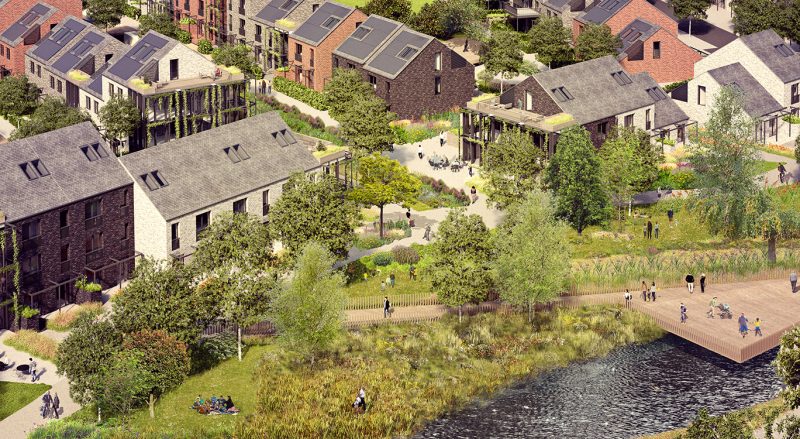
Connector Housing – Openstudio / LDA Design / Hoare Lea / Gardiner & Theobold
Connector Housing
Based around the design of units that work together, Connector Housing relies on ‘Connector’ units to create different building types at that allow flexibility in terms of density and design.
The Connector is a vertical model used to create stairwells, storage and work spaces or to provide access to communal gardens. Combined with ‘base’ and ‘loft’ units, the components can be used to create houses or apartments.Connector Housing was designed by Openstudio with Hoare Lea, LDA Design and Gardiner & Theobald.
Land promoter Leaper Land has put in a planning application for 50 serviced plots at Framlingham in Suffolk, enabling local people to build a custom or self build home of their own.
The proposals were submitted to East Suffolk Council in September 2020 following consultation with local residents, and anyone hoping to self build locally can view the application (Reference: DC/20/3326/OUT) on the councils planning website.
In particular, would be self and custom builders in the region are encouraged to leave positive statements of approval for the site, as all planning applications attract numerous objections.
The application was put together with the landowner, multi-award winning architect Pollard Thomas Edwards and planning consultancy Rural Solutions on the proposals. As a land promoter, Leaper Land works to support custom and self build schemes coming forward in rural locations, with Leaper supporting the landowner to create a viable opportunity of serviced plots.
The Framlingham site includes a range of local improvements, including work to make the Victoria Mill Road safer for a larger development, a new neighbourhood play area and improvements to drainage, footpaths and ecological enhancements. These include new native tree and hedge planting, with landscape design is by Collington Winter.
In the application Leaper Land stressed the urgent need for custom and self build housing in East Suffolk, with 410 people signed up to the East Suffolk self build register. Leaper has conducted wider research into appetite for custom and self build that indicates significant unmet demand locally.
Find East Suffolk’s Self Build Register on the Right to Build Portal
Custom and self build are individuals who purchase a serviced plot of land and act as their own developer – whether by employing their own design and build contractor or simply configuring certain aspects of the design or finish.
Building a custom or self build home means you have the unique freedom to design and build the home that best suits your needs and requirements. You can be as involved as you want to be in the process, from working with expert designers and contractors to build exactly what you want and need, to designing and managing the entire process.
Leaper Land has proactively addressed a range of questions on its website, such as how the proposal works with the local and neighbourhood plans, such as minimum indicative housing requirements.
The proposals also include affordable housing provision, including an allocated 17 homes (34% of the total), with a mix of discounted market price, shared ownership and affordable rent.
“Our research shows there is strong demand for Custom and Self-Build homes in and around Framlingham and so our proposal, if granted permission, will make a significant contribution to satisfying that demand. We are excited at the prospect of creating a beautiful new community which closely reflects the local vernacular while also providing a unique opportunity for individuals to get closely involved in the design of their new homes,” says Ben Marten, Director of Leaper Land.
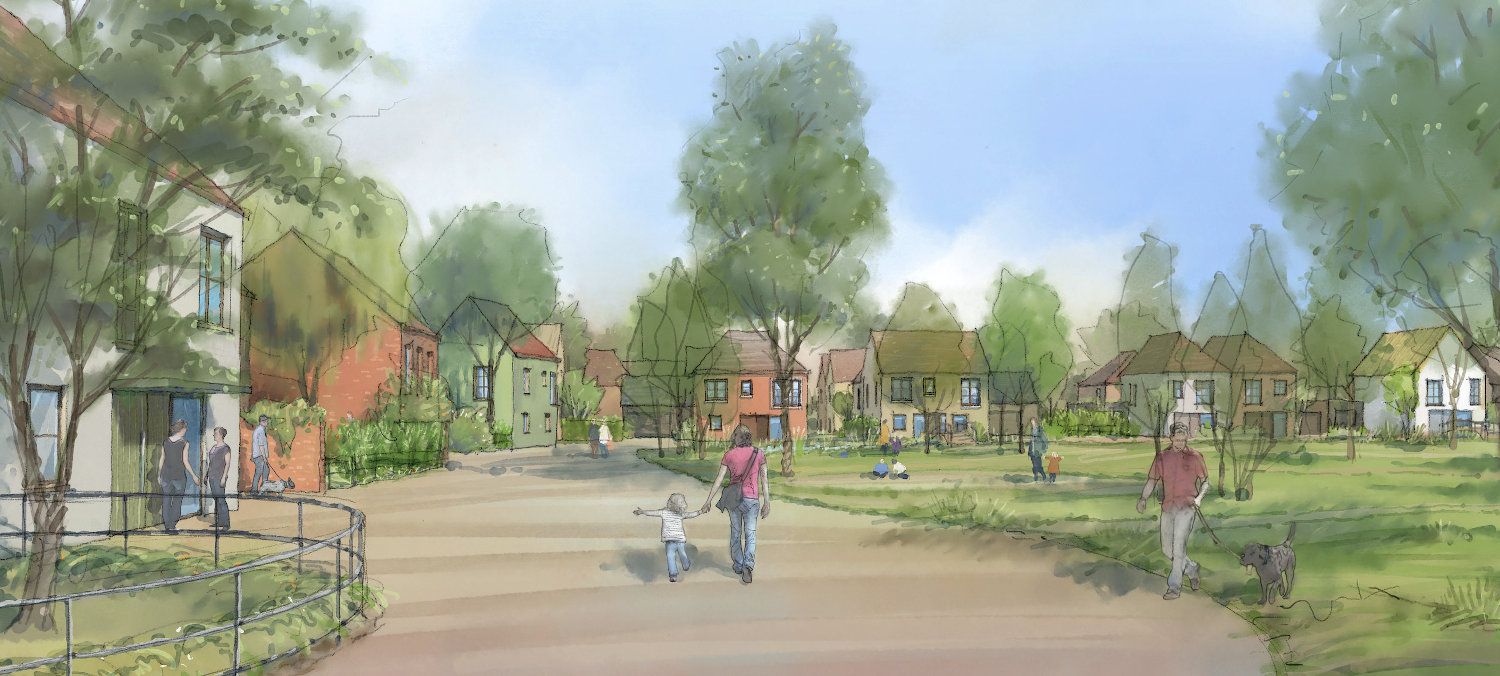
Leaper Land has also applied for planning in Child Okeford in North Dorset
If you have land that you think would be suitable for custom or self build, get in touch with Leaper Land.
Images: Pollard Thomas Edwards/Leaper Land
New research into the aspirations of those that want to self build has revealed that 1 in 3 adults in Great Britain are interested in self building at some point in the future.
Released to mark Right to Build Day on 30 October, the research reflects the appetite of the public for a home in which they have had a role in designing and commissioning.
NaCSBA and the Building Societies Association (BSA), who commissioned the research, wanted to get a fresh perspective of self build intentions and the effect of COVID-19 on people’s feelings about their home.
In terms of people’s aspirations to self build, the data found that:
- Nearly a third of GB adults (32%) are interested in designing and building their own home.
- 9% of people said they were likely to build their own home at some point in the future. This compares to around 5% of new homes currently being built as custom and self build annually**
- Interest is highest in the young, with nearly half (48%) of those between 18 and 24 saying they were interested. This aspiration reduced with age, with less than 1 in 5 (18%) of those aged 55 and over being interested.
- The main benefit for building is seen as the ability to design a home to the owner’s exact specifications (74%), followed by the ability to create a home that can adapt to meet current and future needs (50%).
- Finding the money to finance the project, including mortgage finance, is seen as the biggest hurdle (59%).
- A third of people said living in a home that had less impact on the environment and was more sustainable was a key benefit of building a home (33%), and nearly 9 in 10 people (89%) said energy efficiency would be important if they were to build a new home.
In response to COVID-19 and the way we see our homes, the data showed that:
- Almost 2 in 5 (39%) said the pandemic has made them need a home office space.
- Almost half (48%) said they would like more space as a result of the lockdown. 36% said they would like more indoor space, and 37% said they would like more outdoor space.
- Nearly a third (31%) have considered home improvements at some point in the future as a result of lockdown.
- 1 in 20 (5%) considered designing and building their own home in response to the crisis.
Younger interest
NaCSBA and the BSA welcome the news that it is the youngest generation of 18-24 who are most interested in self building (48%), as they represent a new market. However, there is a disconnect, as it is the younger generations who tend to have the least amount of savings and less earning potential due to their age.
This marries with the perception that financing the build project is the most significant limiting factor preventing people from self building. 59% cited this as the most significant barrier.
To help meet the deposit gap, the 2019 Conservative party manifesto promised that the Help to Buy scheme would be extended to the sector, which NaCSBA continues to push for.
Greener building
Having a smaller environmental impact was also a key factor behind the ambition to self build, with a third (33%) of people identifying it as a core benefit of building a home. Almost 9 in 10 (89%) of people said it was important that their newly built home was energy efficient, when asked to envision building their own home.
Housing diversification is a core part of the Government’s wider housing strategy, as England has the lowest known rate of self-commissioned homes in the world. The Right to Build legislation requires councils to grant sufficient planning permissions to match the demand evidenced on their registers.
However, despite legislation in 2015 and 2016, the survey found that 83% of people had never heard of the registers held by local authorities of people who would like to build their own home. NaCSBA urges all those looking to self-build to sign up to their local Right to Build register via www.righttobuildportal.org.
THE PANDEMIC AND OUR HOMES
It is no surprise that the COVID-19 crisis has affected people’s perceptions of what they want out of their home, with the need for a home office being important for 39% of people.
Further to this, the lockdown inspired almost 1 in 3 British adults to consider making home improvements as they re-evaluated their living space (31%), while 1 in 20 (5%) considered going on to design and build their own home as a response to the crisis. Clear evidence that the pandemic has made many of us reassess what we want out of a home.
Andrew Baddeley-Chappell, NaCSBA’s CEO said, “The current lack of choice in our new homes market makes it different from every other country and every other consumer market. Only when there is diversity of choice will we get the diversity of homes that we want and need.”
Paul Broadhead, Head of Mortgages and Housing at the BSA said, “It’s great to see that there are so many aspiring self and customs builders, particularly among the youngest generation (18-24yrs). Increased levels of home working this year have led many to realise the importance of future proofing their homes to suit their individual needs.
“Mutual lenders are leading the way to help these self-build dreams become a reality, with 21 building societies currently lending to people building their own homes, they are the clear choice for many and are leaders in this space.”

Building societies offering self and/or custom build products:
| Bath Building Society |
Beverley Building Society |
| Chorley Building Society |
Darlington Building Society |
| Buckinghamshire BS |
Earl Shilton Building Society |
| Dudley Building Society |
Furness Building Society |
| Ecology Building Society |
Ipswich Building Society |
| Hanley Economic Building Society |
Mansfield Building Society |
| Loughborough Building Society |
Penrith Building Society |
| Melton Mowbray Building Society |
Saffron Building Society |
| Progressive Building Society |
Scottish Building Society (Scotland only) |
| Stafford Railway Building Society |
Swansea Building Society |
| Vernon Building Society |
|
Start your self build journey by signing your local self build register – find yours at www.righttobuildportal.org
About the survey:
NaCSBA and the BSA commissioned YouGov to conduct the survey. Data is based on total sample size of 2017 adults, with the survey carried out online on 9th-11th October 2020. Figures are weighted and representative of all GB adults (aged 18+).
Share this on
Head to the National Self Build and Renovation Centre for its show on Friday 16-Sunday 18 October, which is one of the few shows still running a live event.
The National Self Build and Renovation Centre is a permanent exhibition space dedicated to self building, with permanent stands and educational exhibits helping you to navigate the process of self building or renovating a home.
The show is the ideal event to meet experts and see and test products in a spacious and relaxing setting – with measures in place to ensure social distancing requirements are met.
The show offers something for everyone, no matter what stage you are at with your project – whether you are still at the early planning stage or part way through.
The centre has experts on hand with offering a range of advice, from finding a plot and arranging your finances to deciding on the best building method for you. As well as lots of information about heating systems, green building and more.
National Self Build & Renovation Show:
When: Friday 16th – Sunday 18th October
Time: Fri & Sat: 9:00am – 5:00pm; Sun: 9:00am – 4:00pm
Where: NSBRC, Just off M4 Junction 16, Swindon, SN5 8UB
Tickets: Free in advance, £12 on the door.
CREATING A COVID SAFE EVENT
Special measures have been put in place to ensure the NSBRC and show safeguard its visitors, exhibitors and staff. It is working hard to ensure it complies with current guidelines and as such this show will be a little different from previous events.
In order to maintain social distancing, the centre is reducing the capacity of the event and requires all attendees to book in advance on this occasion. Tickets are limited to a maximum of 2 adult members per household, and children must remain with their parents at all times.
Additional measures have been implemented for the safety of all, which will be explained on the day.
On 19 and 20 September, Bicester-based self and custom build development site, Graven Hill, will be talking all things self-build at Build It Live.
The event is going virtual this year, taking place entirely online. From the comfort of your own home, you’ll experience a whole weekend full of inspiration, interviews and top tips from a range of experts.
Graven Hill has a long-running partnership with hosts, Build It, having opened the Build It Education Hub in November 2019. Home to the site’s Marketing Suite, the Hub is a self-build project itself, giving visitors the opportunity to learn about the various aspects of building their own home, including product choice, design, and construction methods.
These are just some of the many topics Graven Hill will be exploring during the virtual event, with attendees able to book live one-to-one chats or video calls with the team throughout. Whether you want to discuss plot availability, financial options, or just have a burning question, the Graven Hill experts will point you in the right direction to making your dream home a reality.
There will be an interview with self-builders, Zakima and Sam Omotayo, as well as Graven Hill’s managing director, Karen Curtin, at 1.10pm on the Saturday. They will be speaking about why Graven Hill was right for them, their self-build process, and offering advice to prospective self-builders. This will also include a live Q&A, so attendees can ask any questions they may have to people who have experienced self-building first-hand.

Self Builders Sam and Zakima Omotayo
Zakima and Sam, said: “Being able to share our self-building journey with an audience of like-minded people is something we’re really looking forward to. Our experience at Graven Hill has been so rewarding, and if we’re able to inspire others to take the plunge then that’s the cherry on the cake.
“Self-building is an option that people rarely consider in the UK, but we’d love to see that change. We now live in a home that reflects our style and needs, and we are very happy.”
For those unsure about whether self-building is right for them, the Graven Hill team will also be able to explain the site’s custom build new homes. These take the ease of a conventional new build and combine it with the personality of a self-build. Perfect for people who want a unique home without the heavy lifting.
Eligible for Help to Buy, custom build new homes are also accessible to all, including those aiming to get a foot on the housing ladder.
Karen Curtin, managing director of Graven Hill, said: “The UK has yet to fully embrace the concept of self and custom building, and Build It Live gives us the opportunity to spread the word about its potential, as well as quash certain misconceptions. At Graven Hill, our aim is to provide an accessible route to building your dream home, something that is often dismissed due to time and cost.
“This year’s event may be virtual, but we’re certain it’ll inspire a whole new set of budding self-builders to give creating a home that fits their every need a try.”
Whether you’re looking to start a self-build project of your own or are just curious about what Graven Hill has to offer, make sure to book your place at Build It Live. For exclusive offers, speak to the site’s sales team during the show.
The Competition and Markets Authority (CMA) is investigating four of the UK’s largest housebuilders following “troubling evidence” in the way that leaseholds were sold.
The action concerns Barratt Developments, Countryside Properties, Persimmon Homes and Taylor Wimpey, following the sale of private newbuilds as leaseholds as opposed to the traditional freeholds. Buyers allege that the leaseholds are unfair in that the grounds rents due on the homes can escalate.
The housebuilders are all happy to work with the CMA to help ascertain the facts.
Andrea Coscelli, chief executive of the CMA, said: “It is unacceptable for housing developers to mislead or take advantage of homebuyers.
“Everyone involved in selling leasehold homes should take note: if our investigation demonstrates that there has been mis-selling or unfair contract terms, these will not be tolerated.”
It is believed that millions of such leasehold homes were sold across the UK. As well as annual ground rent being levied, some leases charge owners for permission to extend or make improvements to their own home.
The situation has been complicated in some instances by the leaseholds being treated as a commodity, sold on to third parties to be managed, who have then increased fees.
Housing Secretary Robert Jenrick said: “Shameful practices of the kind set out by the CMA have no place in our housing market and we are going to put an end to them.
“I want to see homeowners who have been affected by crippling ground rents swiftly obtain the justice and redress they deserve.
“Developers and freeholders must rectify the problems and ensure these disgraceful practices never happen again.”
What are the implications for self build?
Most self build homes are freehold properties, where the owner also owns the land the home is built on. But with the growth in custom build, more and more serviced plots will be delivered, and these should ideally be on a freehold basis.
However, for many community-led housing models, the homes are held by a body that ensures affordability or acts as a landowner for the group, such as with the Community Land Trust model. In this instance, these homes will be leasehold, which is perfectly acceptable as the body holds the land in trust, to secure the advantages.
Community-led housing bodies have, and continue to, lobby government to ensure that they are exempt from any new rules or laws that limit the sale of houses on leases, with Community Land Trusts now exempt.
If you are planning to build as a community, find out more about the National Community Land Trust Networks campaign on leasehold reform.
Image: by Shahid Abdullah from Pixabay



